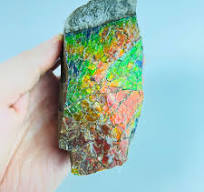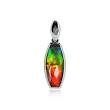May 19, Day 10, Glaciers, Lakes and Mountains
- randolf50
- May 20
- 7 min read

The title sums it up. Today was a day full of seeing, smelling, touching, tasting and hearing various glaciers, lakes and mountains.
We ate breakfast this morning at the Forest Park Hotel, then checked out. Our tour bus arrived a bit earlier than the pre-announced 8:30am time. However, Patrise was ready and secured two front row seats for us, as well as had the driver to load our luggage. Today, we would be part of a group heading down the Icefields Parkway, seeing and visiting several sights along the way to our evening hotel, the Fairmont Chalet, Lake Louise. After picking up the rest of our tour group, our driver/guide pulled over and introduced himself and invited all of us to introduce ourselves. We had folks from Arizona, California, the UK (Great Brittain), Kentucky, and New Hampshire, in addition to Patrise and me from Georgia. Norm, our guide for today, indicated he grew up on a farm in Saskatchewan, served in law enforcement for thirty years, subsequently worked as a long-haul driver for fourteen years, and now was serving as a tour guide for the past nine years. Here is Norm.

Norm proceeded to drive to our first stop, while giving us facts, tidbits, and history of various forest locations, buildings, and events along the way. He told us about the fires of last summer, including: how the fires created their own tornados; how the town was overwhelmed so quickly by the fires (started as forest fires east of town but within two hours the town was being evacuated); how the town was evacuated without any loss of life or significant injury (all of the tour guides and buses provided free emergency transportation); how the fires were set up to be devastating to the forest due to the high incidence of dying and diseased trees (pine beetles had infected and weakened over 60% of the trees); how the forest responds and rejuvenates after major fires. Since the fires opened up the forest canopy, grasses and bushes which previously could not grow or thrive due to the lack of sunshine, are now filling in the forest floor rapidly. The bushes include blueberry and other berry bushes: meaning that within 2-3 years, the park rangers and ecologists expect Jasper National Park to become the new bear capital of Canada, since bears love to fill up on berries.
We made our way to our first stop, Athabasca Falls. As Norm said, they are not Niagara Falls by any means, but these falls still have a powerful and dramatic beauty of their own. Here are several –probably too many – photos of Athabasca Falls and me and Patrise enjoying the site.
The falls are part of the Athabasca River, which is the longest river in the province of Alberta. It travels northwards, eventually flowing into the Mackenzie River, which in turn ends at the Artic Ocean. Here is a map of that.

After Athabasca, we made our way to the Sunwapta Falls area, passing several notable geological features in the process. We also learned a lot about ammonite and ammolite. Ammonite is a mineral composed of fossilized sea creatures (cephalopods) from millions of years ago. Ammolite is a gemstone derived from ammonite. It has become more popular in recent decades and of course our stop at the Sunwapta Falls Lodge just happened to have some samples on hand. (The “scratch-my-back-I’ll-scratch-yours” arrangement between tour operators and local merchants was on full display.) Here are photos of ammonite and ammolite.
Photos of Sunwapta Falls Lodge, ammonite rock created by pressure of glaciers, ammolite jewelry.
After the Sunwapta Falls stop, we drove to a scenic stop location across from a glacier, to have our lunch. At the beginning of the trip, Norm had passed out box lunches each rider had preordered. Now we were stopping to eat those lunches before pushing on to the Columbia Icefields location. The weather was sunny, but quite cool. We ate for about 35-40 minutes on benches looking toward the glacier that was shrouded in low-lying clouds. All this time we were carefully watched by a local raven that had greeted us when we stepped off the bus in the parking lot. It was looking to score an easy meal, first sitting perched atop a pole watching us eat, and then perched on top of the garbage bin, waiting for us to drop some crumbs. Here are pics of our raven friend. After this brief lunch, we reloaded the bus to leave.
We pushed on to the Columbia Icefields location, hearing stories from Norm along the way: stories about a man from Georgia – the state, not the country – leading an effort to locate and restore B-17 bombers; stories about local characters; stories involving the country’s challenges with adapting road infrastructure to accommodate electrical cars, due to batteries not functioning well in cold climates. Along the way to the Columbia Icefields, we were blessed to see a young black bear emerging from a wooded area, roaming not too far from the roadside. Norm immediately stopped the bus, so all of us could “oo” and “ah” and take a thousand photos each. Many of us had been on wildlife tours in Jasper, the day before. None of us had seen a bear nor a moose on the wildlife tour. Now, without the expectation of seeing a bear, we ran across one in the height of the day. It was not scared off by the hissing sound the bus makes before opening the door. So, we had lots of good views of the creature, as it wandered in and out of the local shrubbery. Here are some of my 1,000 photos of the black bear. (I exaggerate, but not by much.)
Leaving the bear reluctantly, we continued to drive to the Columbia Icefields Centre.
As we got close, we passed a Skywalk which juts out over a portion of a canyon floor over 900 meters above the ground. Norm said that we would later come back to this site, to actually walk the skywalk – at least for those of us who desired to do so. We arrived at the Centre shortly before 12 noon. After disembarking, we walked into the Centre and received our instructions from Norm. We would go as a group to load onto a Brewster bus. (A Brewster bus is just a 55-person motorcoach bus, but in this case the fleet is operated by the Brewster company. The Brestwer boys – reported to be 12 years of age, when they began their transport company – are one of the stories Norm had told us on the way here.) The Brewster motorcoach bus would take us to a location near the glacier where we would transfer to a Terra Bus. The terra bus would take us onto the glacier itself for about 30 minutes. We would then have to get back onto the same Terra Bus to be taken back to the transfer location to be picked up by any Brewster bus. Once picked up, the Brewster busses would then take us to the Skywalk. After which, we would return to the Discovery Centre. We had to be back no later than 3:45pm, or we would be left behind as the tour then eventually made its way south to Lake Louise and Banff National Park.
1st row: glacier selfie, looking at 2nd and 3rd levels of the Columbia Glacier, glacier visitors
2nd row: representing Georgia Tech, glacial meltwater, our Tera Bus in the background
3rd row: stream of glacial melt water, noting my feet on the ice, the footprints I've left behind
I will not provide any more details about this portion of the day’s activities, except to report that Patrise opted NOT to get off the bus at the Skywalk, while I got off to take in the experience. Of course, we reconnected at the Discovery Centre upon my return. Here are photos taken along the way to the Columbia Icefields Centre, taken throughout the glacier experience, taken from my brief Skywalk excursion, and taken as we departed the area for Lake Louise.
Upon leaving the Columbia Glacier and heading for Lake Louise, we stopped briefly to see the Weeping Wall. The Weeping Wall gets its name from the rivulets of water that continuously seep out of the rock and stream down as mini waterfalls. However, in the winter, these rivulets of water merge together and become a solid sheet of ice. This attracts rock climbers and ice climbers from around the world, who scale the cliff face without equipment – no pitons, axes, or ropes. Just climbing with fingers and toes (or more accurately gloves and shoes). The other distinction about the Weeping Wall is that park rangers and glaciologists familiar with the glaciers throughout Jasper and Banff parks say that the 1200-ft height of the Weeping Wall is the average depth of the glaciers throughout the park. Can you imagine ice 1200-ft thick? That is a lot of pressure and one of the ways in which glaciers have shaped our lands throughout the history of the earth. Here are photos from the Weeping Wall.
Heading from the Wall to our next stop, Lake Louise, where Patrise and I would be staying the night, I mostly dozed. I don’t mind saying that I was tired of hearing Norm’s stories, as well as just tired from all the day’s events.
We arrived Lake Louise, at the Fairmont Chalet. Oh my, what magnificent accommodations, even if only for one night. As we tried to check in, the two of us were escorted from the 1st floor reception are to the 7th floor reception for the “Gold Area” check in. I’m still not sure how this happened, perhaps it was something we said to our Fresh Tracks travel agent. At any rate, we were not complaining at all. We checked into our room, went to the Gold Lounge for evening canapes, then rested a bit before heading to our 7:30pm dinner reservation in the chalet’s Fairview Restaurant. What a treat: the ambiance, the meal, our Filippino server, Qin (“Chin”), and our view of Lake Louise. All combined to make for a spectacularly leisure way to end the day. Here are photos from check in to bedtime.








































































































































































Comments